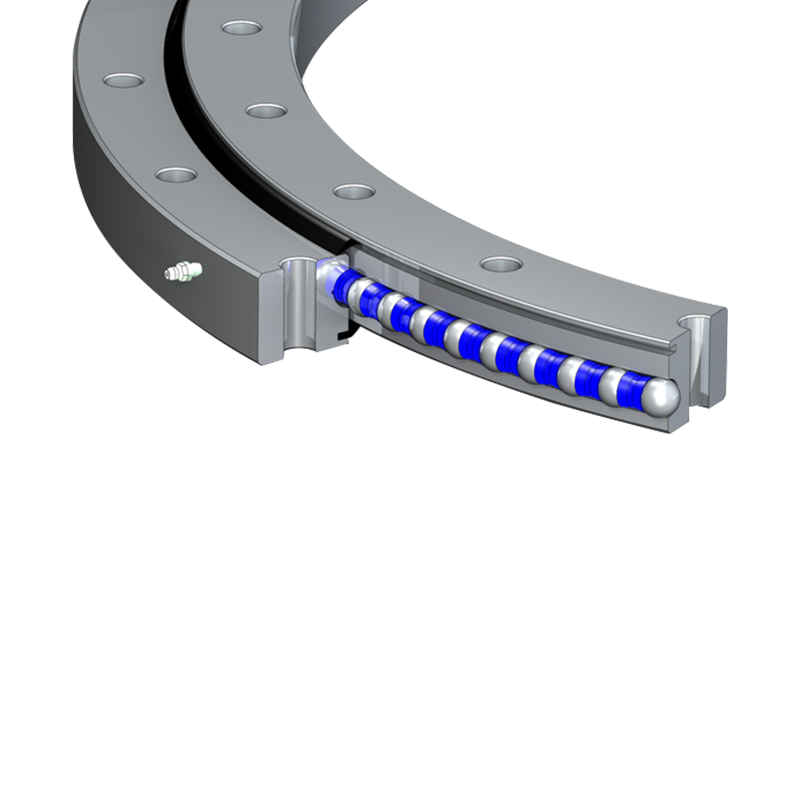What are the advantages and limitations of using single-row ball slewing bearings in high-precision applications?
 2025.01.10
2025.01.10
 Industry news
Industry news
Single-row ball slewing bearings offer several advantages and limitations when used in high-precision applications. These bearings are commonly employed in systems that require rotation and load support, such as radar systems, solar tracking devices, and robotics. Here's a breakdown of their advantages and limitations in high-precision applications:
Advantages:
High Load Capacity:
Single-row ball slewing bearings can handle axial, radial, and moment loads simultaneously, making them suitable for applications that require the bearing to support multiple types of forces, such as in robotic arms or positioning systems.
Even in high-precision environments, these bearings can handle substantial loads without compromising on accuracy.
Compact Design:
The single-row ball configuration typically results in a more compact and lightweight design, which is crucial in high-precision applications where minimizing space and weight is important, such as in aerospace, satellite systems, or precision machinery.
Smooth and Accurate Rotation:
The ball design ensures smooth and continuous rotation with minimal friction, which is essential for high-precision positioning and tracking applications (e.g., telescopes, camera mounts, or wind turbines).
The low friction helps maintain high positioning accuracy over long operational lifespans, important for systems requiring high repeatability.
Reduced Maintenance:
Compared to more complex bearing systems, single-row ball slewing bearings are relatively simple in design, making maintenance easier and reducing downtime in high-precision systems. They often require less frequent servicing than other bearing types.
Versatility:
These bearings can be used in various orientations and for different axes of rotation, providing versatility in integrating them into different high-precision machines without needing significant modifications.
The design allows them to be used in both small and large applications, offering flexibility across different sectors.
Cost-Effectiveness:
While not the cheapest option, single-row ball slewing bearings offer a good balance of cost and performance, making them suitable for high-precision applications where budget constraints exist without sacrificing too much on performance.
Limitations:
Limited Load Capacity for Extremely High Precision:
Although they handle substantial loads, single-row ball slewing bearings may not offer the same load capacity as multi-row or roller slewing bearings, which could be necessary for extremely high-precision applications that require both high rotational accuracy and the ability to support very heavy loads (e.g., large radar systems or heavy machinery).
In applications requiring high dynamic loads (such as in robotics or cranes), their load limits may cause limitations in performance or lifespan.
Sensitivity to Misalignment:
Single-row ball slewing bearings are sensitive to misalignment or improper installation. Even slight misalignment can result in increased wear, reduced precision, and early failure.
High-precision applications demand perfect alignment to avoid performance degradation, and this can be challenging to maintain consistently over time.

Risk of Ball Deformation under High Stress:
In high-precision applications with repeated or high stress, the balls can deform over time, leading to increased friction and potentially compromising rotation accuracy.
The elastic deformation of the balls could result in minor inconsistencies in rotation, which may be unacceptable in critical applications like precision machinery or optical devices.
Backlash and Runout:
Backlash (the slight play between the ball and the raceway) and runout (the deviation from true circular motion) can affect the precision of the system. While single-row ball slewing bearings offer relatively low backlash compared to other bearing types, they may still experience some backlash under high precision requirements, such as in high-speed or high-torque applications.
This issue can lead to slight inaccuracies in positioning, which may not meet the strict tolerances required in high-precision tasks.
Less Suitable for Very High-Speed Applications:
Single-row ball slewing bearings are not designed for extremely high-speed rotation or applications with fast cyclical motion. High-speed applications can generate more heat and friction, causing increased wear and decreasing the accuracy of the bearing.
In high-precision tasks requiring high-speed rotation, other bearing types (e.g., magnetic bearings or air bearings) may provide superior performance.
Environmental Sensitivity:
While some high-precision applications might require the bearing to operate in harsh environments (e.g., extreme temperatures, humidity, or exposure to contaminants), single-row ball slewing bearings can be vulnerable to corrosion and wear in such conditions, reducing their performance and accuracy.
To mitigate this, protective coatings or seals are necessary, which can add to the cost and complexity of the system.
Limited Precision in Highly Dynamic Systems:
In applications where the bearing is subject to dynamic forces or vibration, such as in high-precision machinery or equipment subject to fluctuating loads, the single-row ball slewing bearing may struggle to maintain the high level of precision needed. These bearings might be better suited for more static or low-dynamic load scenarios.
Temperature Sensitivity:
Excessive heat buildup from high-speed rotation or heavy loads can negatively affect the performance of single-row ball slewing bearings in high-precision applications. The material properties of the balls and raceways can change with temperature, causing the bearing to lose accuracy and performance.
Precision applications often require temperature-controlled environments to avoid this issue, which may not always be feasible in all situations.












